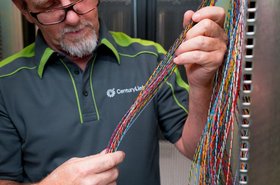Whether a shopper is scrolling on a smartphone or browsing in a brick-and-mortar store, it is undeniable that retail is in the midst of a major transformation. From deliveries by drone to augmented reality in stores, what was once the realm of imagination or science fiction is quickly becoming a reality, thanks to a beefed-up edge of the network and, soon enough, 5G technology.
This digital transformation impacts both the supply and demand sides of retail, including factories, transportation, drones, robots, and augmented reality. The way consumers make purchasing decisions is changing, and the ability of retailers and e-tailers to accept, adopt, and adapt to new technologies will likely impact the success of their businesses.
The following examples show how technology-embracing retailers may optimize a shopper’s experience from a warehouse shelf to a consumer’s hands.
Smarter factories
According to McKinsey, factories and other production environments have the potential to realize the biggest financial impact from the application of the Internet of Things (IoT). They predict the industrial IoT will generate an economic value of between $1.2 trillion and $3.7 trillion by 2025.
This digital transformation is evident on the factory floor of a warehouse or distribution center. The supply chain is already highly automated and will only get more advanced in the near future.
Smart factories leverage the convergence of IoT, cyber-physical systems, and cloud computing to allow manufacturers to use real-time data to increase efficiency, reduce costs, and adapt to changes in demand. For example, advanced analytics can show whether warehouses are over or understocked on particular items, to be able to better respond to consumers’ changing needs. Realizing the full value of smart factories will require robust Edge infrastructure.
Transportation is well integrated with smart factories, and the technology is already mature. Beyond tracking an individual truck or vehicle, technology allows us to track fleets of vehicles. Operators can ensure fleets of trucks are in the right place at the right time with the right products on board. Technology in the smart transportation and logistics space includes intelligent transportation systems, fleet management and telematics, guidance and control systems, smart vehicle applications, toll and ticketing systems, and security and surveillance systems.
Telematics-based commercial fleet management systems are helping transportation companies minimize vehicle investment risks, reduce transportation and staff costs, improve transport efficiency, and increase productivity. Transportation will be enhanced by the imminent roll-out of 5G, allowing for even more advances.
These technologies also can help alleviate issues of traffic congestion, safety, pollution, and the efficiency of goods transportation and delivery. For example, a study of the impact of smart traffic control signals in Pittsburgh showed that intersection wait times had fallen by up to 40 percent, journey times by as much as 25 percent, and vehicle emissions by up to 20 percent.
A future with robots and drones
In the near future, perhaps even just a few years from now, it may be common for a customer to walk into a grocery store with no human cashiers behind the register.
Autonomous robots already are working alongside humans in warehouses. These robots rely on cameras and other sensors to collect information on their environment, including the presence of people, and adapt to the environment in real time. Improvements in vision and gripping technology enable robots to pick parts in warehouse operations - and could help them stock grocery store shelves or scan customers’ purchases.
A future with robots will require a robust and secure compute infrastructure to ensure that the solutions are available and safe. The infrastructure system needs to be self-healing with built-in redundancy.
Drone technology has progressed from simple remote-control operation to intelligent piloting and autonomous flying modes. In fact, PwC estimates the current global market for commercial applications of drone technology to exceed $127 billion based on their ability to disrupt a range of industries that extend from agriculture to film-making.
In addition, their ability to capture data has been enhanced and now includes HD and 4K video. As the technology has progressed and become more intelligent, the amount of operational and collected data is increasing exponentially.
Package delivery companies are experimenting with drones to expedite parcel delivery. The widespread adoption of drones will be influenced by the many regulatory issues facing the technology, and could be positively impacted by the advances made possible with 5G technology.
Enhancing the customer experience
Retailers are using digital technologies to enhance the in-store experience, better understand and predict customer behaviors, and create a more seamless experience for customers moving between in-store and online channels.
Smart Retail allows for the personalization of a customer’s experience in a physical store or in an online environment, using analytics about that customer’s behaviors and preferences. The low latency and high bandwidth capabilities of 5G become critical as the volume of data increases.
Today, the level of targeting is fairly generic – like a retailer offering a coupon to a customer who has recently purchased an item in-store or who has browsed the retailer’s website. Retailers can push alerts to an app when a customer is near a target location, thanks to Bluetooth beacons and WiFi access points.
Soon, data will allow retailers to be more precise and sophisticated. For example, facial recognition technology could identify a customer as he or she enters the store or through embedded facial recognition in a retailers app, analyzing information about previous visits to a store within the chain cross-referenced with online search, demographics, and other relevant patterns. The retailer could then recommend specific products or deals to that person. This level of personalization would require pulling external data rapidly from multiple sources.
5G is also important for improved accuracy within locations. Rather than simply knowing a customer spent time at the mall, for example, a retailer could know that a customer passed by a store location and spent time looking at products in the window.
The current network isn’t robust enough to take full advantage of these opportunities. With current technology, the volume of data can’t be accessed and processed fast enough to support this level of personalization and customization.
Some retailers are providing more interactive experiences by experimenting with augmented reality, a way of imposing a computer-generated image onto a user’s view of the real world.
One cosmetics brand, for example, has deployed “magic mirrors” that scan the shopper’s face and virtually present multiple makeup options using the company’s products. Another retailer is experimenting with “virtual fitting rooms” as window displays. Using kinetic technology, they allow passersby to see themselves in the store’s featured items before even entering.
These seamless, interactive experiences rely on the ability to deliver information with low latencies. 5G will provide a boost to the evolution of augmented reality.
In the future, “mixed reality,” enabled by 5G, will become commonplace. A customer could see what a paint color would look like on the walls without opening a paint can or could see if a new couch would fit in the living room before making the purchase. With these immersive experiences, latency and bandwidth become even more critical.
From the factory to the product reaching a customer’s hands, data and the digital world are revolutionizing the retail experience. These advancements will rely on robust infrastructure, fast and agile networks, and secure systems, all enabled by the edge and 5G.





